
The Yamaha CR-620 was one of Yamaha’s mid-range units from 1977-1979. It produces 35 watts per channel into 8 ohms. It has the classic Yamaha styling and was rated at 0.015% total harmonic distortion. The unit weighs in at just over 23 pounds. The CR-620 was part of Yamaha’s CR-xx20 series that included the CR-220, CR-420, CR-620, CR-820, CR-1020, CR-2020, and, eventually, the monster CR-3020.
Front Panel
The CR-620 stereo receiver has a sleek and minimalist design. The front panel is made of satin aluminum with a long dial cut-out in the center. The dial cut-out contains no decorative bezels or multi-colored illumination, giving the CR-620 a clean and uncluttered look.
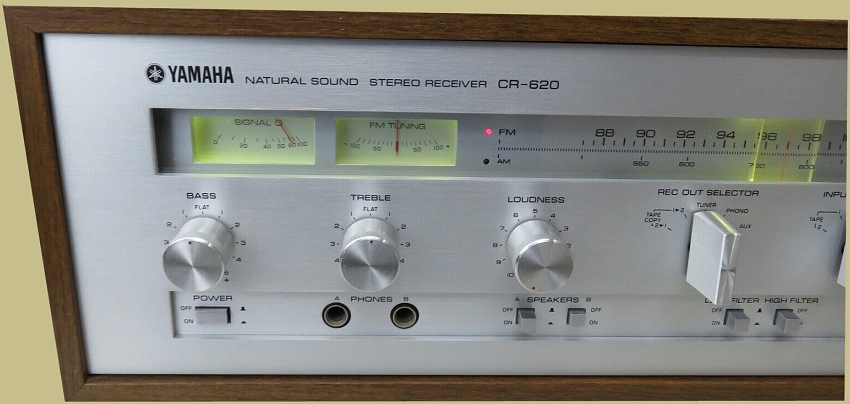
The main tuning dial in the center is flanked by red LED power and stereo indicators. Additional LEDs indicate whether the AM or FM tuner is selected. Two large analog meters next to the dial display the FM center channel tuning and signal quality.
Below the meters are bass and treble tone controls, each with eleven detented positions. The center settings provide a flat frequency response so there is no need for a tone defeat switch. A loudness control boosts low and high frequencies as volume is decreased, improving sound at lower listening levels. Concentric volume and balance (center-detented) controls are on the right, along with a tuning knob.

Two bar-knob switches on the center panel enable flexible input selection. One switch chooses between a tuner, two tape decks, phono input, and auxiliary input. The other switch controls which source is routed to the tape recording outputs on the rear panel. This facilitates dubbing between tape decks.
Push buttons across the bottom of the panel control power, two pairs of speakers, high/low filters, stereo/mono mode, and FM muting. Two headphone jacks are also conveniently located up front.
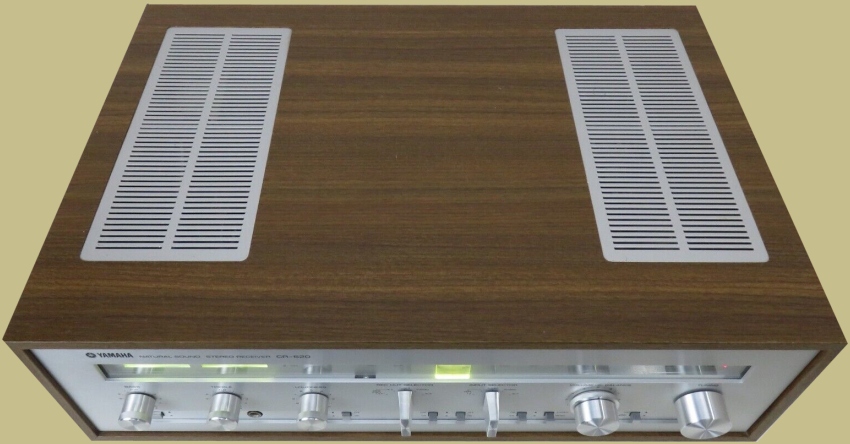
Natural Sound
Yamaha uses the term “Natural Sound” to describe the audio quality and performance of some of their stereo receivers and other components. The CR-620 is part of the Natural Sound series. The key aspects of Yamaha Natural Sound include:
- Flat frequency response – The receivers strive for highly accurate reproduction across the audible frequency range, without artificial boosting or cutting of certain frequencies. This provides a smooth, natural tonal balance.
- Low distortion – Using high quality parts and circuit design, Total Harmonic Distortion (THD) is minimized. This reduces unwanted audio artifacts and coloration.
- Wide dynamic range – A high signal-to-noise ratio and dynamic power provide clear resolution of subtle details at both very low and very high volumes.
- Precise imaging – Careful attention is paid to stereo separation and soundstage replication. This allows accurate placement of sounds and instruments in space.
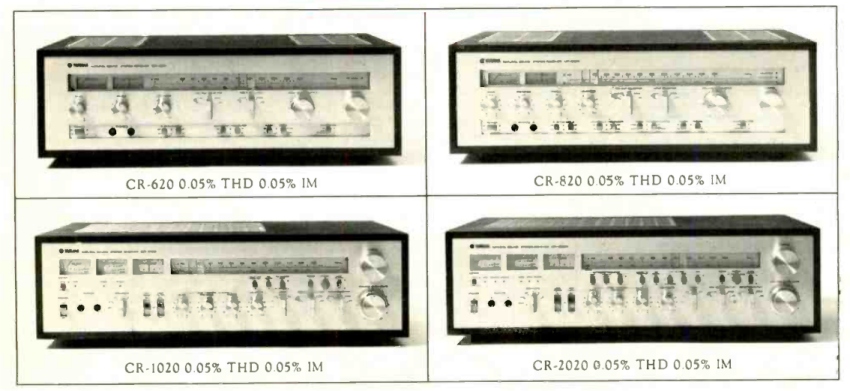
The goal of Natural Sound is high-fidelity reproduction that conveys all the nuances and emotions of a live musical performance. It aims to avoid artificial effects like boosted bass or treble that may initially seem impressive but ultimately sound unnatural. Yamaha Natural Sound products are designed to be accurate, balanced, and realistic. Some feel this was just a marketing gimmick used by Yamaha to sell receivers but there really is a different sound, especially from the earlier receivers. To some it may sound sterile but to others it sounds clean and accurate.
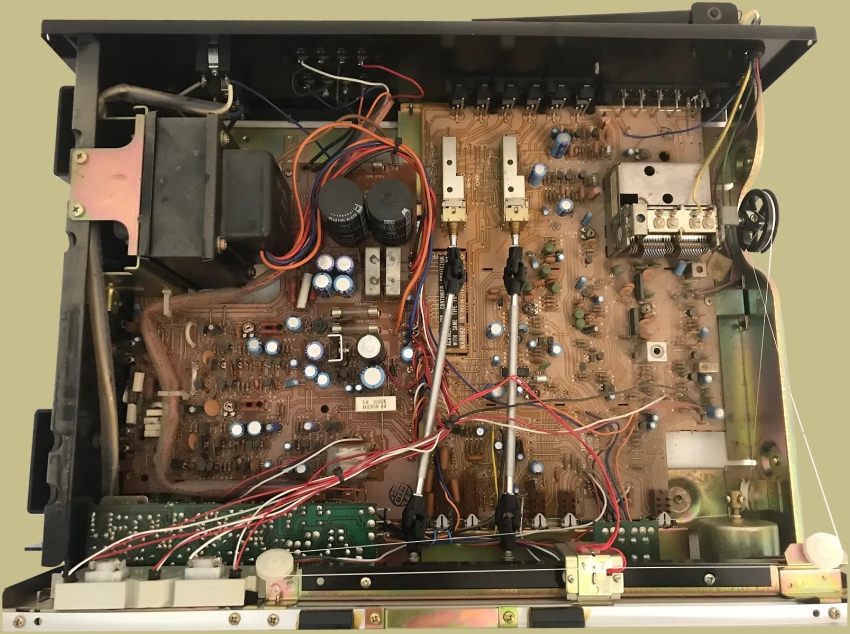
Rear Panel
The rear panel of the Yamaha CR-620 stereo receiver has a number of useful connections. Antenna terminals are provided for 75 and 300 ohm FM antennas. A screw-type binding post for a wire AM antenna is also included, along with a hinged ferrite rod AM antenna.
The two terminals of speaker outputs use insulated spring clip connectors, which provide a secure grip on speaker cables. Three AC power outlets are located on the rear, with one being switched. This switched outlet can be used to turn connected components on and off along with the receiver.
The Yamaha CR-620 combines excellent tuning capabilities and tone control with flexible input and tape recording options. Its refined design focuses on providing quality sound reproduction and an intuitive user experience.

With its refined yet functional design, the CR-620 offers an great blend of performance and flexibility. The FM tuner is excellent and independent tone controls allow you to tailor the sound to your liking. Whether listening to vinyl, CDs, or the radio, the CR-620 delivers Yamaha’s Natural Sound quality for accurate and realistic reproduction. And with useful features like two headphone jacks, switched AC outlets, and connections for two sets of speakers, the CR-620 is a versatile receiver well-suited for a vintage audio setup.

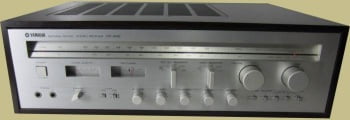
I would like to know if the Yamaha cr-620 receiver uses a ceramic or a magnetic cartridge on the phono input ?
Not sure about magnetic or ceramic cartridges. The phono input is designed for MM cartridges though.
Do not know what an mm cartridge is… does it need a pre-amp for the turntable ?
MM is Moving Magnet as opposed to an MC or Moving Coil cartridge. The cartridge fits on the turntable tonearm and acts as a mini amplifier. The CR-620 phono circuit is designed for MM cartridges. Just check to see if you’re turntable has an MM cartridge on it. If it does then you can hook the turntable directly to the receiver. Just run your cables from the turntable to the Phono inputs on the back of the CR-620 (including the Ground wire) and you should be good to go. The CR-620 has preamp and amplifier circuitry built into it. Of course, you’ll need speakers as well. For more info on the cartridges check out This Site.
It uses a magnetic cartridge.
To find a pleasing sound with a Yamaha receiver, I have found that this is what works for me. First, set the volume. For me, that’s at 2 (9 o’clock). Then set your Loudness setting. For me, that’s at Flat (5 o’clock), which counter-intuitively is actually at its Full setting. Then I set the Bass at +1 and the Treble at +2. Voila, a nice, full, rich sound you can enjoy for hours. With that signature understated Yamaha Bauhaus styling, you’ll be in audio heaven.
This Yamaha receiver has one major problem, it’s not great on bass. In order to get any good bass you have to crank it up all the way to 5, it was improved in next generation models or in higher models CR-1020 and 2020. Otherwise sound is really incredible and it’s my most favorite minimalist / elegance design of all receivers.
I currently own a CR-620 and I find it has a very satisfying sound to it. That may be different things to different people, but matched with some Large Advent speakers, I would dare to find a match in that category for quality sound. I bought mine for ridiculously cheap because the FM dial string is broken. However, I don’t listen to much of the commercialized FM stations anymore and just use it for the amplification. Plenty good in my opinion.
Looking at pretty clean 620 and would like opinion vs Kenwood KR 6050 for same price. Will run DCM CX27 and Thorens turntable. Thoughts?
If you like the ‘Natural Sound’ of the Yamaha’s then I would go with the CR-620. But, in terms of value the Kenwood is worth more $$. Probably about $50-$100 more, if that matters to you. Plus the Kenwood has 60 watts as opposed to the Yamaha’s 40. Still, both are very nice receivers and you can’t really go wrong with either. Just my 2 cents.
Would this drive a pair of Polk T50s?
I own the Yamaha CR 620 and had it restored and love it through my Monitor Audio Bronze 100’s. Question, has anyone had any experience with Planar Magnetic headphones with the on board amp? I’m interested in the new Hifiman XS or Sundara and do t want any additional peripherals. Will the Yamaha drive either of these?
I haven’t had my CR-620 very long, but I’ve had no problems using my Sundaras with it so far. Setting the volume around 3 1/2 (10 o’clock) with loudness on flat gets the volume about as high as I’d ever want it.
I had mine re-capped and I really like it. I take back my earlier comments about setting the tone controls. Just set the Loudness to Flat and let the engineers’ volume and loudness interaction calculations take care of it. Easy-peasy.
Curious to know what all you had done in your restoration (e.g. brand and quality of caps, other components replaced, etc) and did the tuner get adjusted to optimize channel selection (Q).